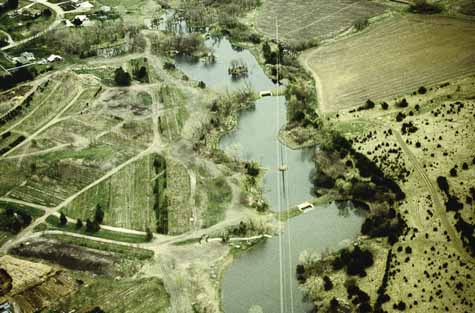Antelope Commons Projectby Kristen Schmidt |
 It may seem commonplace in other parts of the country, but installing effective urban erosion and sediment control practices in Lincoln, Nebraska is rare. Before last year, capitol city developers did not have a model available for reference even if they did wish to apply conservation measures to their sites. Enter the Lower Platte South Natural Resources District. To fill this void, the political subdivision prepared a 400+ page Manual of Erosion and Sediment Control and Stormwater Management Standards. The manual is a tool for planning boards, governmental bodies, property owners, developers, contractors, consultants and others to provide information on minimizing erosion and sediment problems as well as address water quality concerns on land undergoing urban development. The document shows, in detail how to use soil, water, plants and man-made structures to improve the quality of our environment. Included with the Manual is a sample ordinance that has been presented to Lincoln's Urban Stormwater Task Force for consideration. At this time, there is no enforcement from the City of Lincoln for developers to design an erosion control plan for land disturbing activities. The district is relying on the leadership of Lincoln's developers to voluntarily be good stewards of the land. One such volunteer is Urth Propriety's Richard Speidell. Speidell approached the Lower Platte South NRD with a plan unlike any other that had been attempted in Lincoln. As the owner of Nebraska Nurseries, Speidell realized that urban encroachment on his property was prompting him to convert the wooded area to a residential development. From the beginning, Speidell's vision included a plan that would minimize the impacts on the existing landscape. More than forty percent of Speidell's Antelope Commons Development Project will remain as open space. Within that area, Antelope Creek winds through the property. ANTELOPE COMMONS WETLAND PROJECTA Cooperative Venture
The Lower Platte South NRD and Richard Speidell teamed up to create a unique and aggressive plan for protecting water quality in Antelope Creek and Lincoln's Holme's Lake which lies just 1/2 mile downstream of the Antelope Commons development. The project included the construction of a system of four wetland cells within the creek channel. Each pond is separated by a low weir with simple stop log structures for controlling water levels. The depths and shape of each wetland pond was carefully calculated to provide proper settling of sediments as they reach the uppermost structure. The perimeter of each pond includes a shelf of wetland vegetation adding to the natural filtering process of sediment and nutrients. The uppermost pond is essentially a sediment trap that will be dredged as it fills with incoming sediment. Water depths in each of the other three ponds range from about three to fifteen feet. The wetland project, completed in June 1995, is being monitored by the Nebraska Department of Environmental Quality. Initial data has already shown a significant reduction in sediment loading to Holmes Lake as a result of the Antelope Commons Wetland Project. Visitors to the project can visualize the sediment filtering process in action. Following rainfall events, one can compare the varying degrees of water turbidity in each of the ponds. The uppermost structure remains murky, much like a marsh, and water clarity improves dramatically as you move downstream along the project. One of the most notable characteristics of this project is that all the work was put in place BEFORE any ground was moved for residential development. The project preserved the integrity of the land and enhanced the natural beauty of the area. The Natural Resources District regards this project as a model for other developers in Lincoln. The Antelope Commons Wetland Project is a key component in the Salt Valley Clean Lakes Project. This is a cooperative effort of the NRD, U.S. EPA, Nebraska Dept. of Environmental Quality and University of Nebraska Cooperative Extension. An EPA Section 319 Grant was obtained by the NRD to assist with efforts to reduce non-point source pollution in the Holmes Lake Watershed. Written in the grant was $168,000 to be applied to the Antelope Commons Project. Additional matching funds were obtained by the Nebraska Environmental Trust Fund. With a little perseverance, Speidell's vision for the Antelope Commons project became a reality. He has created a truly unique setting that is carefully buffered from the hustle and bustle of city life. New homeowners in the development will be able to enjoy the Antelope Commons Wetlands from their own backyards. All the area will be open space for residents to visit. Speidell also plans to open a portion of the property up to the public for recreation and education. He is working to develop an "outdoor classroom" that will focus on the benefits of urban erosion and sediment control. The NRD applauds the VOLUNTARY efforts of this local developer. It is a bold, responsible step that we all hope will begin to change the way future developments are approached within Lincoln's city limits. |
©2004 - 1998 Land and Water, Inc.